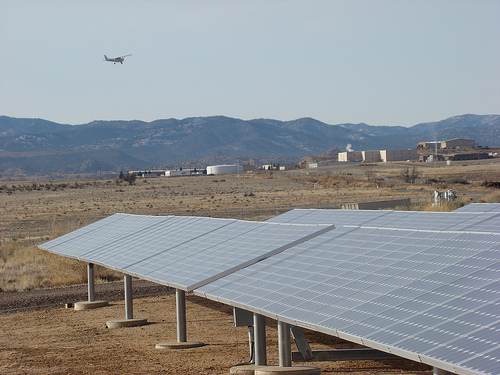Can you picture yourself running in a 5K race on a crisp winter morning at the top of a 10,678-foot, snow-covered peak in snowshoes? That’s what approximately 150 adventurous people did when they competed in the 11th annual Sandia Snowshoe Race on Jan. 19, 2013.
The race is sponsored by the Friends of the Sandia Mountains, with proceeds supporting the preservation and maintenance of the trails and picnic areas on the Cibola National Forest and Grasslands‘ Sandia Ranger District in Tijeras, N.M.
The Sandia is a compact district of around 100,000 acres that includes the 37,200-acre Sandia Mountain Wilderness just east of Albuquerque. Because of its proximity to a metropolitan area, more than 1 million people visit the district each year. Visitors come for a variety of recreational activities – hiking, mountain biking, picnicking, rock climbing and horseback riding. In the winter, weather permitting, there’s cross-country skiing and snowshoeing. Read more »

An American Redstart sings from his perch deep within the Chippewa Flowage Watershed. Photo by Eric Olsen.
The Wisconsin Chippewa Flowage Forest Legacy project was selected March 15 to receive a U.S. Forest Service Wings Across the Americas award for their efforts in wild-bird habitat management.
Every year, the Forest Service recognizes outstanding work by partners and local Forest Service employees in conserving habitat for birds, bats and butterflies. This award highlights the outstanding partnership of the Wisconsin Department of Natural Resources, the Trust for Public Land, and the U.S. Forest Service for work in land stewardship and bird conservation in northwestern Wisconsin. Read more »

Converting airport grasslands to biofuel, solar or wind production may not only provide more environmentally sound alternative energy sources, but also increase revenue for airports and reduce the local abundance of wildlife hazardous to aircraft. U. S. Department of Agriculture research is helping shed light on this promising concept. USDA photo by David Bergman.
Most people are familiar with the weekly summer ritual of mowing the lawn. At best, the smell of fresh cut grass is appealing, but often the task is considered time consuming, tiring and expensive. What if your “lawn” was actually hundreds of acres in size, and how often you mowed it, what type of grass you had, and if you used pesticides greatly impacted the safety of nearby residents? “Mowing the lawn” is just one of the tasks airport managers and biologists confront as they work to keep wildlife away from runways and aircraft. Read more »

The Clearwater Project provides critical habitat for Canada lynx, grizzly bears, and bull trout, all federally listed endangered species. The Forest Legacy Program supports state efforts and has helped to protect more than 2 million acres of environmentally sensitive forest lands across the U.S.
The U.S. Forest Service‘s Forest Legacy Program, working with Montana Department of Fish, Wildlife, and Parks, the Trust for Public Land, and the Nature Conservancy, and local groups helped permanently protect more than 10,000 acres of Montana forest land on Wednesday, July 27, protecting it for wildlife habitat and future generations of Americans. Read more »
The new Farm of the Future project profiles working farms, forests, and ranches that are participating in environmental markets or receiving payments for ecosystem services. In the five case studies just released, landowners changed their management practices to provide water quality, wetlands, wildlife habitat, and carbon benefits—generating new revenue from the sale of ecosystem services to supplement traditional income. Read more »
Tags: Biodiversity, Conservation, EcoAgriculture, Environment, Farm of the Future, NRCS, OCE, Office of Environmental Markets, water, watershed, Wildlife
 Conservation
Conservation
In 1999, Yreka High School in Yreka, California received funds from a Forest Service Grant (Partners in Flight Program) to enhance their agriculture and natural resource program and provide wildlife habitat on school grounds. These funds were used to build a songbird garden, purchase fencing, materials for an irrigation system, and a greenhouse structure. The students and instructors constructed the fence, irrigation system and the greenhouse. Read more »



